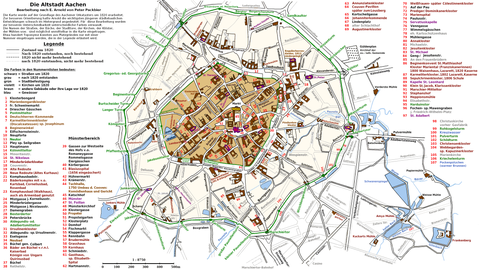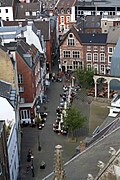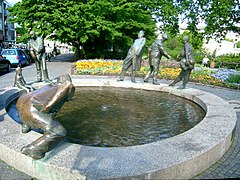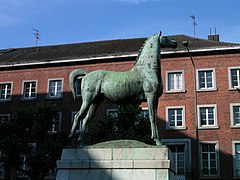Aachen old town
The old town of Aachen , the old Aachen, be embraced historical center of the city of Aachen the area that from the Middle Ages until the end of the 18th century from the Aachen city wall was surrounded.
location
Aachen's old town is located in the Aachen-Mitte district south of the Lousberg within the Aachen basin. The boundaries of the formerly walled area are largely marked by the Alleenring, which follows the course of the city moat originally located in front of the city wall from Kaiserplatz via Heinrichsallee, Monheimsallee, Ludwigsallee, Pontwall, Turmstraße, Junkerstraße, An der Schanz and Boxgraben to the Marschiertor . Between Marschiertor and Kaiserplatz, however, the course of the Wall did not follow today's traffic routing of the Ringstrasse past the main train station and the normal clock , but ran roughly along today's streets Wallstrasse, Schützenstrasse, Gottfriedstrasse and Martin-Luther-Strasse.
geography
A ridge stretches along Jakobstrasse from southwest to northeast to the market. While when entering the old town at the end of Jakobstraße he is still about 200 m above sea level. NHN , it is only 175 m above sea level on the market . NHN and from there falls away quickly in all directions. The highest point in the old town is 204 m above sea level. NHN the hill on which the Long Tower stands. The deepest point is about 159 m above sea level. NHN near Kaiserplatz.
From the Aachen brooks , Pau , Paunell and Johannisbach run mostly piped through the old town, join in the area of Adalbertstrasse and Stiftstrasse and flow northeast of Kaiserplatz into the Wurm . Part of the Johannisbach has been exposed again since 1999 and flows in a channel from Lindenplatz along the streets Annuntiatenbach and Augustinerbach to Pontstraße .
history

In the place of today's old town of Aachen there was already a settlement in Roman times, known as Aquae Granni since the Middle Ages , with several thermal baths that used the hot water of the Aachen thermal springs . Even after the Romans left, the settlement remained inhabited, and the Franks came to the area during the Great Migration. In the 8th century, Charlemagne had his royal palace with a palatine chapel and thermal baths built near the settlement . Otto the Great was crowned Roman-German king in the Aachen Palatinate in 936 , which established the tradition of the coronation of Roman-German kings in Aachen , which continued until 1531 .
The history of Aachen as a city began in 1165, when Emperor Friedrich I Barbarossa granted the settlement, which had developed around the Royal Palatinate, market and mint rights and made it a Free Imperial City . In 1171 construction began on a city wall that was 2.5 km long and encompassed an area of 45 hectares. It is usually called "Barbarossa Wall" after its initiator.
The rights granted by Friedrich Barbarossa caused a rapid increase in population, so that the city soon grew beyond the walled area. The government of the Free Imperial City, which was initially carried out by a royal official, was passed on to a council in 1250 headed by two mayors . In 1267 the grass house was the first town hall to be completed. In 1270, with the financial support of Richard of Cornwall, who was crowned king in Aachen in 1257, the construction of a second city wall , which was about 5.3 km long and covered an area of 175 hectares, i.e. about four times the previous city area. This wall remained the boundary of the actual city area until the end of the 18th century, while the lands and villages in the vicinity of the city were officially placed under the jurisdiction of the city by Emperor Ludwig the Bavarian as the Aachen Empire in 1336 .
In the first half of the 14th century, a new town hall was built on the remains of the royal hall of the old Palatinate . In the second half of the 14th century, a Gothic choir was added to the octagon of the Palatine Chapel . The medieval town, which mainly consisted of timber and half-timbered houses , was largely destroyed in a town fire in 1656, and the roof structure and spiers of the town hall burned down. The reconstruction was initially carried out in the Renaissance style , which was soon replaced by the Baroque . Above all, the baroque builder Johann Joseph Couven and his son Jakob shaped the appearance of the city through their work. On the initiative of the physician François Blondel , Aachen developed into one of the most modern bathing and health resorts of its time in the 17th and 18th centuries thanks to its thermal springs .
With the invasion of the French in 1792 and the annexation of the Rhineland to Prussia in 1815, Aachen became a mayor's office , which in addition to the walled city area included part of the former Aachen Empire. Other parts of the Aachen Empire became independent political communities. In 1802 the former palace chapel became the cathedral as the bishop's seat . The razing of the city walls, begun under Napoleon Bonaparte , was continued in the course of the city expansion in the 19th century, today only a few remains are preserved. After a few large-scale buildings in the classicism style at the beginning of the 19th century, the old urban area and the new quarters outside the walls were mainly built in the various styles of historicism . In keeping with this sense of style, the cathedral and town hall, which had at least been partially redesigned in baroque style, were given a medieval look again. The area of the old town was largely destroyed in the Second World War . The reconstruction was carried out while largely preserving the medieval streets and most of the large buildings that define the cityscape. Some houses have been faithfully restored, others rebuilt. In many cases, the remaining parts of the structure were integrated into the new building or moved to other new buildings . A larger area in the north-west of the old town, as well as adjacent areas in the west quarter and on the Hörn, was used for expansion buildings of the RWTH Aachen . It was not until 1978 that the town hall received new spire helmets, which are based on their medieval appearance, as has been handed down, for example, on a silver pen sketch by Albrecht Dürer from 1520 or on an engraving created by Matthäus Merian in 1647 .
Cityscape
Streets, squares, green spaces
Despite the destruction caused by the town fire of 1657 and the Second World War, the medieval town plan can still largely be recognized. The core of the old town is the former Palatinate district with the cathedral , town hall and the Katschhof in between . By easting the Imperial Palatinate in contrast to the Roman roads following the natural course of the terrain, a number of triangular squares were created in the city center, including the market , chicken market , courtyard and monastery square. Many of the streets and squares near the Palatinate district are designated as pedestrian zones or traffic-calmed , the pedestrian zone extends over Adalbertstraße to Kaiserplatz .
The original course of the Barbarossamauer can still be seen on the Grabenring, a ring road that follows the course of the city moat originally located in front of the wall and whose street names mostly end in "-graben" (Templergraben, Karlsgraben, Löhergraben, Alexianergraben, Kapuzinergraben, Friedrich- Wilhelm-Platz, Holzgraben, Dahmengraben, Komphausbadstrasse, Seilgraben, Hirschgraben). Smaller sections of the Barbarossa Wall have been preserved along this ring road.
In the south, the Grabenring is widened to a square, the Friedrich-Wilhelm-Platz, on which the classical Elisenbrunnen is located. Behind the Elisenbrunnen is the Elisengarten, the only larger green area in the old town. An archaeological showcase in the Elisengarten, like some smaller archaeological windows in the old town, provides insights into archaeological finds from the history of Aachen . At the lower end of Sandkaulstrasse is the small Sandkaulpark. Other green spaces are Veltmannplatz on the northern edge of the old town and the median of the avenue ring between Ponttor and Kaiserplatz.
Buildings
In addition to the cathedral and town hall, the medieval buildings that survived the fire include the two former city gates Ponttor and Marschiertor , some towers of the city wall , the Romanesque Adalbert's Church , the Gothic grass house on the fish market, the Löwenstein house on the market and the large house from Aachen in the Pontstrasse . An example of the still of the Renaissance arrested style in rebuilding after the fire show the house with the house name Red Castle at Büchel that the Granusturm attached to the town hall house Eulenspiegel and the adjoining timber of the mail car . The buildings erected during the Baroque and Rococo periods include, above all, the parish church of St. Peter , the Wylre'sche Haus on Jakobstrasse, built jointly by father and son Couven, as well as the Alte Kurhaus , Haus Brussel am Markt and Haus Monheim am Hühnermarkt , three works by the younger Couven.
At the time of classicism, the pillared hall of the Elisenbrunnen , the theater building on Theaterplatz and the neighboring administrative building , which until 1972 was the seat of the government of the then dissolved administrative district of Aachen , were built. In addition to numerous residential buildings, the neo-Romanesque Kapuziner-Karree on Kapuzinergraben, originally the seat of the main post office, the neo-Gothic Holy Cross Church on Pontstrasse, the main building of RWTH Aachen University on Templergraben in the neo-renaissance style and the neo-baroque bank date from the period of historicism Suermondt on Theaterstrasse. The bank house Kapuzinergraben opposite the theater is built in a mixed style of Neo-Baroque and Art Nouveau , the most outstanding example of Art Nouveau in Aachen's old town is the municipal indoor pool in the Elisabethhalle .
One example of the New Objectivity is the Rogowski Institute, built between 1925 and 1929, next to the main RWTH building. After the destruction of the Second World War, the former Gothic church of St. Foillan was rebuilt in a modern style using the preserved parts. The modern post-war buildings include a building from the Aachen Cathedral Singing School at Katschhof and extensions from RWTH Aachen University : the Audimax on Wüllnerstrasse and the Kármán Auditorium opposite the main building. In the 21st century, the SuperC , a service building of the RWTH Aachen on Templergraben, and the Aquis Plaza , a shopping center on Kaiserplatz, were built.
Fountains and sculptures
In addition to the Elisenbrunnen, the only drinking fountain for thermal water, there are also numerous ornamental fountains in Aachen's old town. The oldest of these is the Karlsbrunnen on the market with a fountain basin designed by Johann Joseph Couven in 1735, a bronze fountain bowl, popularly known as Eäzekomp (= iron bowl or pea bowl), and a statue of Charlemagne cast in 1620. In 1825, the Hotmannspief was built as an ornamental fountain in place of an earlier running fountain. On the four sides of an obelisk there are gold-plated cast iron figures of women in half-relief who hold jugs in their hands, from which water flows into a fountain bowl. The fountain with a fountain figure that was created at the beginning of the 20th century includes, for example, the Fischpüddelchen at the fish market, the chicken thief at the chicken market and the fortified blacksmith on Jakobstrasse.
The Karlshofbrunnen in the inner courtyard of the AOK building on Markt dates back to the 1960s, with its octagonal floor plan reminiscent of the octagon of the cathedral and the educational canon of the seven liberal arts on seven of its eight bronze plaques , the Bahkauv-Brunnen on Büchel, one of them Representing a legendary figure from Aachen and was created to replace a fountain of the same name that was destroyed in World War II, as well as the Türelüre-Lißje fountain in Klappergasse, which represents the content of a traditional folk song. Other modern fountains are the doll's fountain in Krämerstrasse, which invites you to play with its moving figures , the fountain in Hartmannstrasse, in which the circulation of money is symbolized by the circling of water and on the edge of which several figures represent different ways of dealing with money, as well as the ball fountain in Adalbertstrasse, which opens and closes like a blossom .
Numerous sculptures on the streets and squares of the city serve to artistically enrich the cityscape, including the cheerful stallion on the Theaterplatz, which reminds of the importance of Aachen as a riding town, the sweeper on the Annuntiatenbach, which honors this profession as part of the city cleaning , the Klenkes monument at the Templergraben, which is dedicated to Klenkes , used as a greeting and identification symbol by Aacheners , and the umbrella ladies in Großkölnstrasse, alluding to the proverbial Aachen weather.
Facilities
Educational institutions
There are several grammar schools in Aachen's old town . The Kaiser-Karls-Gymnasium am Augustinerbach is the oldest grammar school in the city of Aachen and goes back to a boys' school of the Jesuit community of Aachen that was opened in 1601 . In 1773 it became a municipal school, and in 1803 it was built as a secondary school based on the French model in the dissolved Augustinian monastery on Pontstraße. The former monastery church of St. Katharina has since served as the auditorium of the grammar school under the name Aula Carolina and is available for external events outside of school hours.
The St. Leonhard Gymnasium in Jesuitenstrasse goes back to a secondary school for girls founded by the Sepulchrines . In 1878 the school became a municipal school as part of the Kulturkampf and in 1909 it became a grammar school. The St. Ursula Gymnasium , which was founded by the Aachen Ursulines , is a girls' high school independently sponsored by a school foundation run by the Ursulines.
The RWTH Aachen (RWTH Aachen University) is a University with more than 45,000 students (WS 2018/19). It was founded in 1870 as a polytechnic and 10 years later elevated to a technical university . The central area of the university campus, called Campus Mitte , extends in the northwest of the old town from the Annuntiatenbach over the Templergraben to the Pontwall and to the north beyond the Pontwall. Other university areas are located in districts northwest of the old town, including the West Campus between the Aachen West train station and the Hörn and the Melaten Campus in the Melaten district . In 2012, RWTH Aachen University was awarded the title of Elite University as part of the Excellence Initiative.
Museums
There are several museums in Aachen's old town . The cathedral treasury is housed in buildings adjoining the cloister of the cathedral and houses one of the most important collections of ecclesiastical cultural treasures in the world with the church treasures of Aachen Cathedral. Outstanding unique pieces are the Proserpina sarcophagus , a Roman marble sarcophagus from the 3rd century AD, in which Charlemagne may have been buried, the Ottonian Lothar cross , a lecture cross from around 1000 AD with an ancient cameo , and the late Gothic bust of Charlemagne , a reliquary made around 1350 for the top of Charlemagne's skull .
The Center Charlemagne , which opened in 2014 in a converted administration building at Katschhof, houses the City Museum of Aachen and is the central point of contact for the cultural and historical project of the Route Charlemagne . Other museums in the old town are the International Newspaper Museum in the Great House of Aachen , a museum for the history of newspapers and the press, and the Couven Museum in House Monheim , which shows the bourgeois living culture of the 18th and early 19th centuries in Aachen and the surrounding area .
Theaters and cinemas
There are several theaters in Aachen's old town . The Aachen City Theater was opened in 1825 as a cultural institution for drama and music theater in a new classical building. In 1920 the previously independent Aachen Symphony Orchestra was affiliated with it. It has two performance halls, the "Large Stage" with 730 seats and the "Small Chamber" with 168 seats. The drama and opera performances are attended by an average of more than 130,000 people each year. Symphony concerts usually do not take place in the theater, but in the Eurogress .
Other theaters in the old town are the Grenzlandtheater on Friedrich-Wilhelm-Platz, founded in 1950 , which does not have a permanent ensemble , but instead performs pieces from the repertoire of modern drama with free actors , and the Öcher Schängche , a stick puppet show in the baroque factory on Löhergraben, who has been performing pieces for children and adults since 1921, partly in Oecher Platt .
The cinemas in the old town include the Apollo in Pontstraße, the Capitol am Seilgraben, the Cineplex in Borngasse and the Eden Palast in Franzstraße.
Monument protection
Many of the historic buildings in the old town are registered as monuments in the monuments list of the city of Aachen, above all the cathedral and town hall with the monument numbers 0001 and 0002. Other objects, as well as areas such as Roman settlement remains at Markt and Büchel or a medieval quarter on Kaiserplatz , are registered there as a ground monument.
The Aachen Cathedral was founded in 1978 together with the Cathedral Treasury and its collection by the World Heritage Committee of UNESCO as one of the first 12 World Heritage sites in the World Heritage List was added.
In addition, the inner city center of the old town , which emerged in the early Middle Ages , is within the inner moat ring together with its most important arterial roads up to the outer city wall ( Pontstraße including Ponttor , Sandkaulstraße, Alexander- and Mariahilfstraße, Adalbertstraße including Kaiserplatz , Franzstraße including Marschiertor , Jakobstraße and Königstraße) as well as the Theaterplatz with the theater under the designation monument area downtown according to § 5 of the Monument Protection Act of North Rhine-Westphalia by its own statute since March 27, 2011 as the second monument area in Aachen. This monument area has also served as a buffer zone for the Aachen Cathedral World Heritage Site since 2013.
Web links
- Aachen beautiful old town
- Historic old town Aachen on the website of the Eifel Tourismus (ET) Gesellschaft mbH
- Aachen - a stroll through the old town on the TravelWorldOnline Traveler website
- Aachen old town in the Geoportal Aachen (with monument area downtown )
Individual evidence
- ^ Aachen Cathedral. In: whc.unesco.org. UNESCO World Heritage Center, accessed March 28, 2019 .
- ↑ Monument area downtown. In: Official website of the city of Aachen. Retrieved March 20, 2019 .
- ^ Statute for the preservation of the "inner city monument area". In: Official website of the city of Aachen. Retrieved March 20, 2019 .
- ↑ Decision - 37 COM 8B.51. In: whc.unesco.org. UNESCO World Heritage Center, 2013, accessed March 28, 2019 .
- ^ Aachen Cathedral. Maps. In: whc.unesco.org. UNESCO World Heritage Center, accessed March 28, 2019 .
Coordinates: 50 ° 46 ′ 32 ″ N , 6 ° 5 ′ 2 ″ E



























